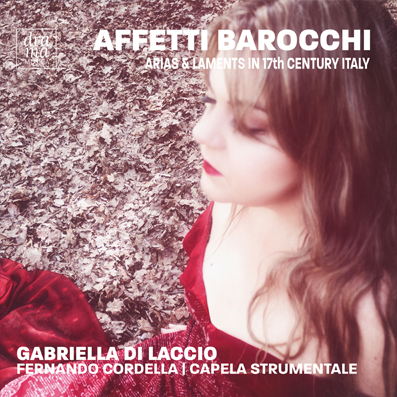
AFFETTI BAROCCHI
Arias & Laments in 17th Century Italy
Gabriella di laccio
fernando cordella
Capela strumentale
DRAMA006
Release Date: 8th April 2019
AFFETTI BAROCCHI
Arias & Laments in 17th Century Italy
17th-century composers did not think of themselves as 'Baroque', a word originally derived from the Portuguese barocco, meaning a pearl of irregular shape, that in the arts was first used in 1855 by the art historian Jakob Burkhardt to describe the distinctive, mostly Italianate styles of the 17th and early 18th centuries. It was even later that music historians adopted 'Baroque' as a convenient term for composers of the Monteverdi-to-Bach era.
But even if the word is anachronistic, the idea of 'pearls of irregular shape' is not entirely inappropriate to the music you will hear on this CD. As Gabriella Di Laccio explains in her essay below, a real revolution in musical style took place in Italy around the year 1600, as scholars, poets, composers and - not least - patrons, all educated in the culture of ancient Greece and Rome, sought to create 'new musics' that threw off the technical complexity, and the Platonic ideals of moderation and balance, of the music of the High Renaissance. As she explains, it is in the repertoire of music for solo voice with a relatively simple chordal accompaniment (the new basso continuo) that early 17th-century composers could most easily find their new-found freedom of declamation and emotional directness. In a time of experiment, a great musical achievement was the discovery and development of ways of communicating the 'extreme affections, ranging from violent pain to exuberant joy.'
In this way the music may often seem emotional in the manner of 19th-century Romanticism. But while the Romantics' emphasis would be on often radical and heroic individual feelings, the 'doctrine of the affects' that underlies most Baroque music has deep roots in the ancient Greek and Roman traditions of rhetorical speech. All revolutions are determined by what has gone before, and Baroque ideas of the affects have their origins in the 15th- and 16th-century rediscovery, mostly in the Italian city-states, of Aristotle's, Cicero's and Quintillian's rhetorical techniques. Already in the time of Josquin (d.1521) rhetorical ideas started to be applied to music for several voices, a movement that gathered pace through the 16th centuries, notably in (for example) Italian madrigals, where composers developed ways of 'painting' the text through dissonance, changes of speed, and vivid decorative figurae.
All this would later have its effect on the 'new musics', and as early as 1555 N. Vicentino, in L’antica musica ridotta alla moderna prattica, Venice, expressed what could have been a manifesto for the new style: 'Now [the orator] speaks loudly, now softly, and more slowly, and more rapidly, and with this he moves the listeners very much …. The same ought to be in music.’ Very soon afterwards, Caccini would be singing in a Floerentine intermedio in what seems to have been the stilo recitativo, which later he would claim (controversially) to have invented. But the main impetus towards this style may not even have come from composers, but from rhetorical scholars and poets, who now wished not only to apply Aristotle's precepts to existing musical style, but to reinvent the actual declamation of the ancient Greeks, such as was the aim of the Florentine Camarata.
Four songs selected on this CD ([1], [2], [6], [11]) are based on the passacaglia, one of the standardised ground bass patterns — in this case, four descending notes in the minor key — used by many Baroque composers to give unity to their compositions. The ever-inventive Frescobaldi, in particular, [2] refuses to be tied down by the variation format but takes the harmony in unexpected directions. Strozzi's masterly L'amante secreto [6]uses a major-key version of the same bass line, brilliantly creating an atmosphere of hidden emotions. The lively ciaconna bass, made famous by Monteverdi's Zefiro torna, is heard in tracks [7] and [9].
The remaining tracks ([4], [5], [8], [9], [10]) are simpler, mostly strophic songs, the three by Monteverdi being described as Scherzi. But even here, a rhetorical performance is desirable, and if the composer gives the same music for all verses (as, for example, in track 8) it is up to the singer to respond to the text differently in each verse. To my ear, Gabriella di Laccio does this most convincingly.
Throughout the recital she is ably partnered by the five continuo and obbligato players of Capela Strumentale, whose imaginative response to the 'bare bones' of this music does much to give it energy and emotional life.
© Timothy Roberts, London, 2018
